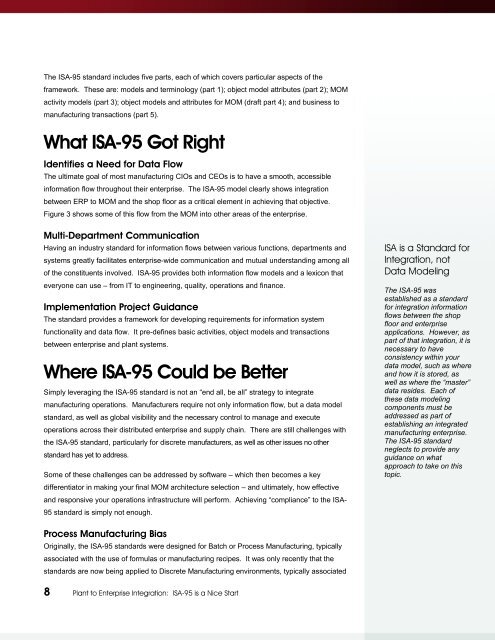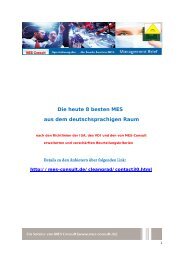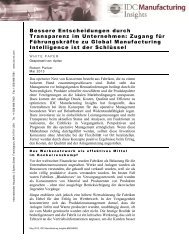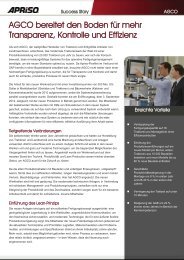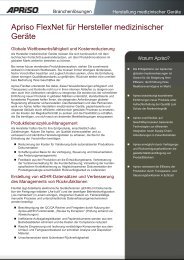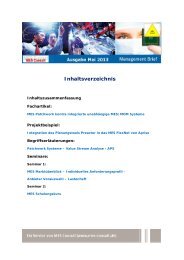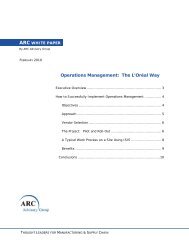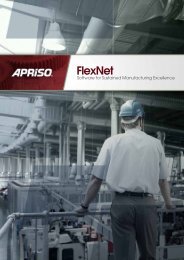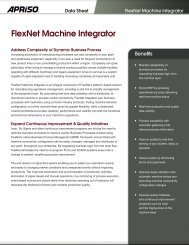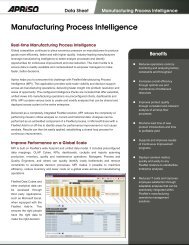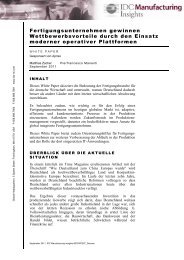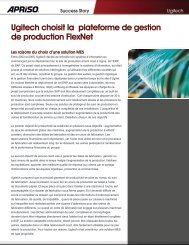ISA-95 is a Nice Start - Apriso
ISA-95 is a Nice Start - Apriso
ISA-95 is a Nice Start - Apriso
You also want an ePaper? Increase the reach of your titles
YUMPU automatically turns print PDFs into web optimized ePapers that Google loves.
The <strong>ISA</strong>-<strong>95</strong> standard includes five parts, each of which covers particular aspects of the<br />
framework. These are: models and terminology (part 1); object model attributes (part 2); MOM<br />
activity models (part 3); object models and attributes for MOM (draft part 4); and business to<br />
manufacturing transactions (part 5).<br />
What <strong>ISA</strong>-<strong>95</strong> Got Right<br />
Identifies a Need for Data Flow<br />
The ultimate goal of most manufacturing CIOs and CEOs <strong>is</strong> to have a smooth, accessible<br />
information flow throughout their enterpr<strong>is</strong>e. The <strong>ISA</strong>-<strong>95</strong> model clearly shows integration<br />
between ERP to MOM and the shop floor as a critical element in achieving that objective.<br />
Figure 3 shows some of th<strong>is</strong> flow from the MOM into other areas of the enterpr<strong>is</strong>e.<br />
Multi-Department Communication<br />
Having an industry standard for information flows between various functions, departments and<br />
systems greatly facilitates enterpr<strong>is</strong>e-wide communication and mutual understanding among all<br />
of the constituents involved. <strong>ISA</strong>-<strong>95</strong> provides both information flow models and a lexicon that<br />
everyone can use – from IT to engineering, quality, operations and finance.<br />
Implementation Project Guidance<br />
The standard provides a framework for developing requirements for information system<br />
functionality and data flow. It pre-defines basic activities, object models and transactions<br />
between enterpr<strong>is</strong>e and plant systems.<br />
Where <strong>ISA</strong>-<strong>95</strong> Could be Better<br />
Simply leveraging the <strong>ISA</strong>-<strong>95</strong> standard <strong>is</strong> not an “end all, be all” strategy to integrate<br />
manufacturing operations. Manufacturers require not only information flow, but a data model<br />
standard, as well as global v<strong>is</strong>ibility and the necessary control to manage and execute<br />
operations across their d<strong>is</strong>tributed enterpr<strong>is</strong>e and supply chain. There are still challenges with<br />
the <strong>ISA</strong>-<strong>95</strong> standard, particularly for d<strong>is</strong>crete manufacturers, as well as other <strong>is</strong>sues no other<br />
standard has yet to address.<br />
Some of these challenges can be addressed by software – which then becomes a key<br />
differentiator in making your final MOM architecture selection – and ultimately, how effective<br />
and responsive your operations infrastructure will perform. Achieving “compliance” to the <strong>ISA</strong>-<br />
<strong>95</strong> standard <strong>is</strong> simply not enough.<br />
Process Manufacturing Bias<br />
Originally, the <strong>ISA</strong>-<strong>95</strong> standards were designed for Batch or Process Manufacturing, typically<br />
associated with the use of formulas or manufacturing recipes. It was only recently that the<br />
standards are now being applied to D<strong>is</strong>crete Manufacturing environments, typically associated<br />
8 Plant to Enterpr<strong>is</strong>e Integration: <strong>ISA</strong>-<strong>95</strong> <strong>is</strong> a <strong>Nice</strong> <strong>Start</strong><br />
<strong>ISA</strong> <strong>is</strong> a Standard for<br />
Integration, not<br />
Data Modeling<br />
The <strong>ISA</strong>-<strong>95</strong> was<br />
establ<strong>is</strong>hed as a standard<br />
for integration information<br />
flows between the shop<br />
floor and enterpr<strong>is</strong>e<br />
applications. However, as<br />
part of that integration, it <strong>is</strong><br />
necessary to have<br />
cons<strong>is</strong>tency within your<br />
data model, such as where<br />
and how it <strong>is</strong> stored, as<br />
well as where the “master”<br />
data resides. Each of<br />
these data modeling<br />
components must be<br />
addressed as part of<br />
establ<strong>is</strong>hing an integrated<br />
manufacturing enterpr<strong>is</strong>e.<br />
The <strong>ISA</strong>-<strong>95</strong> standard<br />
neglects to provide any<br />
guidance on what<br />
approach to take on th<strong>is</strong><br />
topic.


